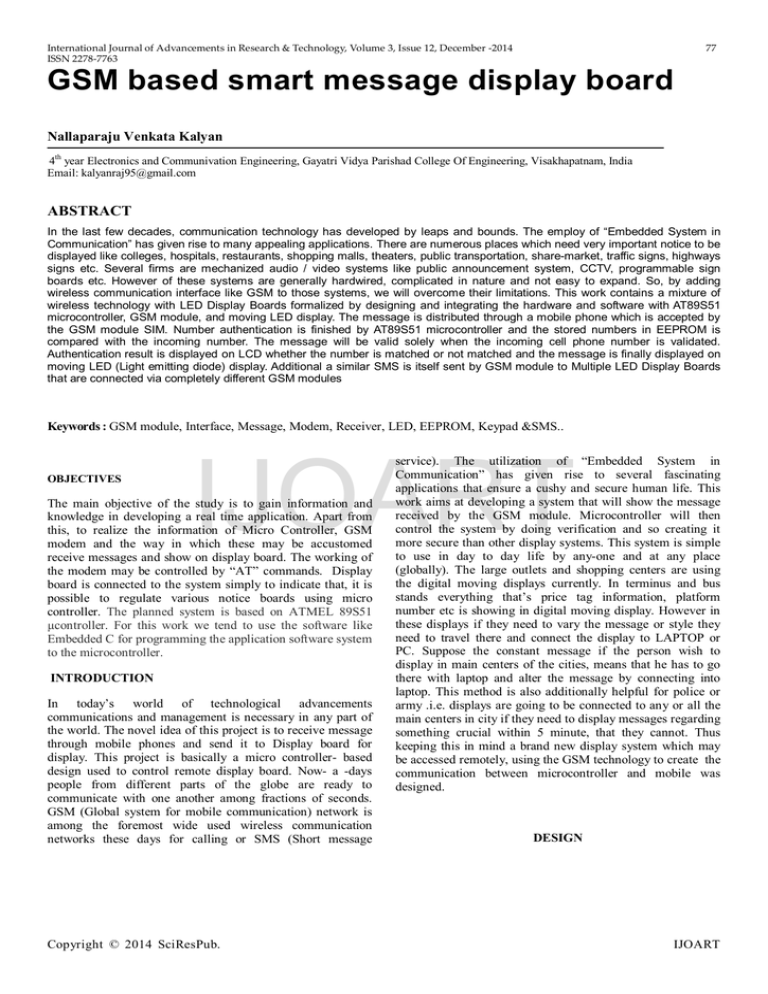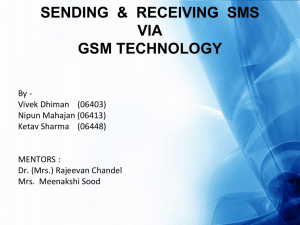Document 14671416
advertisement

International Journal of Advancements in Research & Technology, Volume 3, Issue 12, December -2014 ISSN 2278-7763 77 GSM based smart message display board Nallaparaju Venkata Kalyan 4th year Electronics and Communivation Engineering, Gayatri Vidya Parishad College Of Engineering, Visakhapatnam, India Email: kalyanraj95@gmail.com ABSTRACT In the last few decades, communication technology has developed by leaps and bounds. The employ of “Embedded System in Communication” has given rise to many appealing applications. There are numerous places which need very important notice to be displayed like colleges, hospitals, restaurants, shopping malls, theaters, public transportation, share-market, traffic signs, highways signs etc. Several firms are mechanized audio / video systems like public announcement system, CCTV, programmable sign boards etc. However of these systems are generally hardwired, complicated in nature and not easy to expand. So, by adding wireless communication interface like GSM to those systems, we will overcome their limitations. This work contains a mixture of wireless technology with LED Display Boards formalized by designing and integrating the hardware and software with AT89S51 microcontroller, GSM module, and moving LED display. The message is distributed through a mobile phone which is accepted by the GSM module SIM. Number authentication is finished by AT89S51 microcontroller and the stored numbers in EEPROM is compared with the incoming number. The message will be valid solely when the incoming cell phone number is validated. Authentication result is displayed on LCD whether the number is matched or not matched and the message is finally displayed on moving LED (Light emitting diode) display. Additional a similar SMS is itself sent by GSM module to Multiple LED Display Boards that are connected via completely different GSM modules Keywords : GSM module, Interface, Message, Modem, Receiver, LED, EEPROM, Keypad &SMS.. OBJECTIVES IJOART The main objective of the study is to gain information and knowledge in developing a real time application. Apart from this, to realize the information of Micro Controller, GSM modem and the way in which these may be accustomed receive messages and show on display board. The working of the modem may be controlled by “AT” commands. Display board is connected to the system simply to indicate that, it is possible to regulate various notice boards using micro controller. The planned system is based on ATMEL 89S51 µcontroller. For this work we tend to use the software like Embedded C for programming the application software system to the microcontroller. INTRODUCTION In today’s world of technological advancements communications and management is necessary in any part of the world. The novel idea of this project is to receive message through mobile phones and send it to Display board for display. This project is basically a micro controller- based design used to control remote display board. Now- a -days people from different parts of the globe are ready to communicate with one another among fractions of seconds. GSM (Global system for mobile communication) network is among the foremost wide used wireless communication networks these days for calling or SMS (Short message Copyright © 2014 SciResPub. service). The utilization of “Embedded System in Communication” has given rise to several fascinating applications that ensure a cushy and secure human life. This work aims at developing a system that will show the message received by the GSM module. Microcontroller will then control the system by doing verification and so creating it more secure than other display systems. This system is simple to use in day to day life by any-one and at any place (globally). The large outlets and shopping centers are using the digital moving displays currently. In terminus and bus stands everything that’s price tag information, platform number etc is showing in digital moving display. However in these displays if they need to vary the message or style they need to travel there and connect the display to LAPTOP or PC. Suppose the constant message if the person wish to display in main centers of the cities, means that he has to go there with laptop and alter the message by connecting into laptop. This method is also additionally helpful for police or army .i.e. displays are going to be connected to any or all the main centers in city if they need to display messages regarding something crucial within 5 minute, that they cannot. Thus keeping this in mind a brand new display system which may be accessed remotely, using the GSM technology to create the communication between microcontroller and mobile was designed. DESIGN IJOART International Journal of Advancements in Research & Technology, Volume 3, Issue 12, December -2014 ISSN 2278-7763 This system consists of keyboard through that numbers can be saved in EEPROM. The numbers that are stored in the EEPROM only which will display message on the LED display. So, there is no need to write any code after the SMS. EEPROM is available for saving incoming messages so no previous message is lost even when power failure rather than using on chip memory of controller. The numbers in EEPROM will only be stored after password authentication thus, this method also provides security. LCD is available for displaying authentication results and displaying numbers which are stored in EEPROM. Whole circuit is connected with battery backup thus system can work if there’s no power. Here, we tend to use mobile phones as a message sender, causing messages to notice board by sending applicable SMS and receiving SMS whenever there’s no problem. A GSM modem is connected to the LED display hardware is employed to receive the SMS and send it to the controller circuit of the LED display. Then the controller circuit of the LED display filters the message content in SMS and changes the display text in LED display dynamically. [4]By victimization this SMS service it is possible to vary the text in the LED display panel from anywhere within the country. The system uses a GSM modem at the display side to receive SMS. An IC AT89c51 belongs to microcontroller act as controller to drive the LED display panel. Together with these a power supply unit and supporting hardware for microcontroller is employed. 78 limitations may be removed by the employment of higher end microcontrollers and extended RAM. HARDWARE REQUIRED Microcontroller AT89c51, A wireless GSM MODEM, LED display, Max 232, Memory (EEPROM), Power supply. Microcontroller - AT89C51 : 8051 primarily based CMOS controller with dual DPTR,32 I/O Lines, WDT, PCA, 3 Timers/Counters,7 Interrupts/4 Priority Levels,64K Bytes ISP FLASH EPROM,256 Bytes on-chip RAM.[2] Important role of micro controller in Remote display board using GSM with SMS : The microcontroller within the system is programmed in such a way that once the modem receives any message, the microcontroller can browse the message form serial port and verify for the password, if the pass word is correct then it’ll begin displaying the messages on the LED display system. IJOART Communication between micro-controller and personal computer is over RS232 interface. This provides possibility to drive display over TCP/IP protocol[1]. Fig 2: Block diagram of GSM based smart message display board Fig 1. Design overview of GSM based smart message display system. The toolkit accepts the SMS, stores it, validates it and so displays it within the LCD module. The SMS is deleted from the SIM on every occasion it’s scan, thus creating area for the next SMS. The main constraints incorporated are the employment of „*‟ as the termination character of the SMS and therefore the display of one SMS as a time. These Copyright © 2014 SciResPub. LED is connected to microcontroller as 4 bit data mode, before displaying something on the LED, initialization has got to be done ,so microcontroller can control the LED initialization and select the data register and command register according to the purpose .Memory is connected to microcontroller using two pins, it’s communicating with the microcontroller through I2C communication. GSM : GSM is a cellular network, which means that mobile phones connect to it by searching for cells in the immediate vicinity. There are five different cell sizes in a GSM network—macro, micro, Pico, and femto and umbrella cells. IJOART International Journal of Advancements in Research & Technology, Volume 3, Issue 12, December -2014 ISSN 2278-7763 The coverage area of each cell varies according to the implementation environment. In this system the MODEM is used to access the message sent by the user to display on notice board. This system has many important applications and can be used to update the remote notice board from far off places using GSM MODEM by sending SMS between the mobile and the embedded devices (microcontroller 89c51). This remote control of notice board is possible through embedded system. The microcontroller is interfaced with GSM Modem in mobile phone via MAX232 level convertor. The microcontroller system is designed to allow easy use of a mobile phone to update the notice board at any far location. Using a mobile phone the development of the notice board is being carried out using SMS, this will update the notice board with the help of the microcontroller modules attached to it, which provides the moving message displayed on the LED using 89c51. Subscriber Identity Module (SIM) : One of the key features of GSM is the Subscriber Identity Module, commonly known as a SIM card. The SIM is a detachable smart card containing the user's subscription information and phone book. This allows the user to retain his or her information after switching handsets. METHODOLOGY 79 a modem is connected to any device (computer, fax, etc.,) we need AT commands to direct the modem for its operations. The messages are displayed on the system using high speed techniques, the entire display column is connected to shift register output so that the characters are first shifting to each column and then the microcontroller will switch on the row one by one with small delay. This process is continuing in high speed so the viewer will feel the display in an exceedingly additional brightness. CONCLUSION By employing the concept of wireless technology within the field of communication we are able to create our communication more economical, and faster, with greater efficiency. We can display the messages and with less errors and maintenance. This model will be used very efficiently in institutions like chain restaurants whereby the order and special discounts will be displayed in the least branches simultaneously, in colleges wherein students and staffs will be informed simultaneously in no time. It will be found out at public transport places like railways, bus station, and airport and also at roadside for traffic control and in emergency situations, it is cost efficient system and extremely, easy to handle. Latency concerned in using of papers in displaying of notices is avoided and the information will be updated by the authorized persons. IJOART The mobile used is GSM technology. SMS could be a GSM service by which we are able to send and receive data, to and from another GSM mobile set. The message can be comprised of words or numbers or an alpha numerical combination. The software package checks for whether OK/SAVE key is pressed on keypad. If OK/SAVE is pressed it goes into the software where the numbers are often saved or edited through keyboard in EEPROM to which GSM module sends SMS. If OK/SAVE is not pressed signal strength is displayed on LED. After this it checks whether MENU key is pressed or not on keypad. If it is pressed then software goes within the software password matching. If it is not pressed then it keeps on showing signal strength. If password is found matched then the numbers can be saved or edited through keypad in EEPROM from which GSM module receives SMS. If password does not matches buzzer beeps three times and again shows signal strength on LCD. GSM module invariably checks for incoming SMS. On receiving an SMS, firstly microcontroller saves SMS and number from which SMS is received. Then it compares this number with the numbers stored in EEPROM. Once number matches, Matched is displayed on LCD if not then Not matched is displayed on LCD. After matching the numbers, microcontroller checks for the code “*#1#*”. If it is there in SMS, it displays previous SMS which is stored in EEPROM on Moving LED Display. If SMS is other then this code then that SMS gets stored in EEPROM and is displayed on Moving LED Display. Finally, this received SMS is forwarded to numbers stored in EEPROM by GSM module. Using “attention commands” (AT Commands) GSM modem operations can be controlled. When Copyright © 2014 SciResPub. FUTURE PLAN commercial model can be able to display more than one message at a time. In our system we are sending messages via GSM network and displaying on a LED by utilizing AT commands. The same principle can be applied to control electrical appliances at a distant location. Robots can be controlled in a similar fashion by sending the commands to the robots. This can be used for spy robots at distant locations, utilized by the military to monitor movement of enemy troops. REFERENCES 1. 2. 3. 4. 5. 6. 7. Shereen , N. Z. and Rozumah , B. “Mobile Phone use Amongst Student in University in Malaysia: It correlates and relationship to Psychological Health”. European Journal of Scientific Research. Vol. 37. No.2. pp. 206 – 218, 2009. Sedra and Smith, Microelectronic Circuits, fourth edition, Oxford University Press, 1998. R.S. Sedha, 2002. A Text Book of Applied Electronics, S. Chand and Company Ltd., New Delhi Deng chunjjan, Liu Wei, Zou Kun, Yang Liang “A Solution Of LED Large Screen Display Based On Wireless Communication”, 10.1109/apwcs.2010.24. Gao , W., Zhang, G. and Jiang, X. “Study Implementation of Agricultural SMS Management System”. In Proceedings of IEEE International Conference on Information Technology and Computer Science, 13-17 October 2009, Beijing, China, pp. 1-4, 2009. Bollen, L, Eimler S and Hoppe H.U. “SMS-based Discussions – Technology Enhanced Collaboration for a Literature Course”. In Proceedings of the 2nd IEEE International Workshop on Wireless and Mobile Technologies in Education, 24- 27 May 2004, Germany, pp. 1-2, 2004. Theodore S. Rappaport, Wireless Communications, second edition, PHI. New Delhi. IJOART





